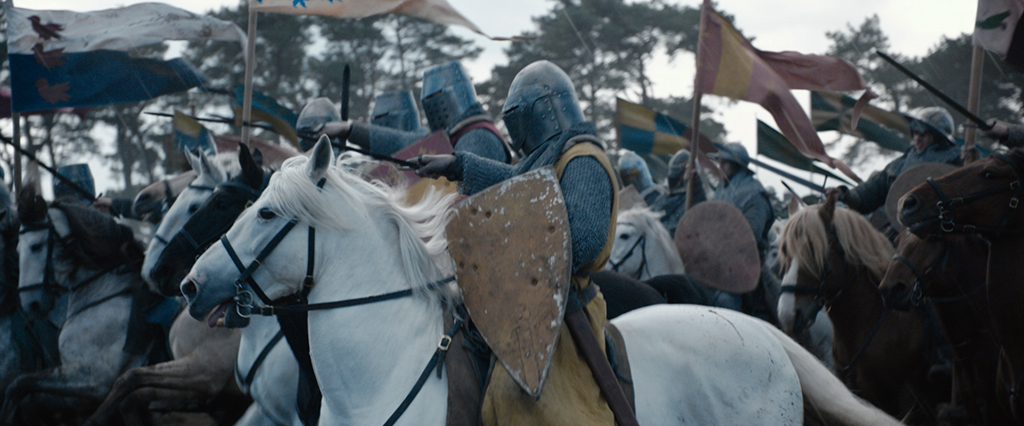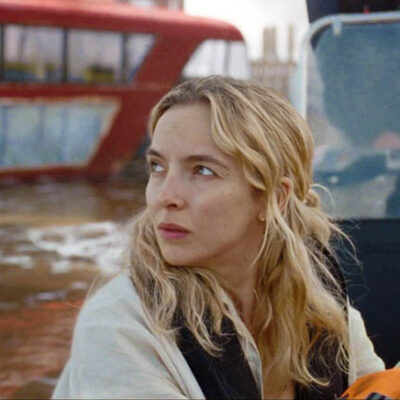Watch the trailer for Netflix’s Outlaw King.
“[Director David Mackenzie] didn’t want to make a visual effects movie. He wanted a great story that basically told the story of Robert the Bruce. With that in mind, we tried to tailor the visual effects to appear as transparent as possible.”
—Alex Bicknell, Visual Effects Supervisor
Adding to the period
Once on board the film, Bicknell soon ascertained that Mackenzie “didn’t want to make a visual effects movie. He wanted a great story that basically told the story of Robert the Bruce. With that in mind, we tried to tailor the visual effects to appear as transparent as possible.”
That meant the visual effects supervisor looked to what was available from the live-action shoots, which, given the vast countryside and still-in-place castles of Scotland and England, went a long way towards the correct 14th century feel.
“I said to David, ‘Let’s go to a place where there’s a castle,’” Bicknell explains. “‘I don’t care if it’s modernized or if it’s got glass extensions. I don’t care if it’s a pile of stones with a little tourist map on it. But we start there and we build up.’ The other thing I’d learned from previous projects was that if you just go to an empty field and you shoot and then say, ‘Put a castle there,’ you can never quite pull it off. If you go to the real location that had the real castle in, you’re getting so much more from it. And then the visual effects are about just scraping back the history.”
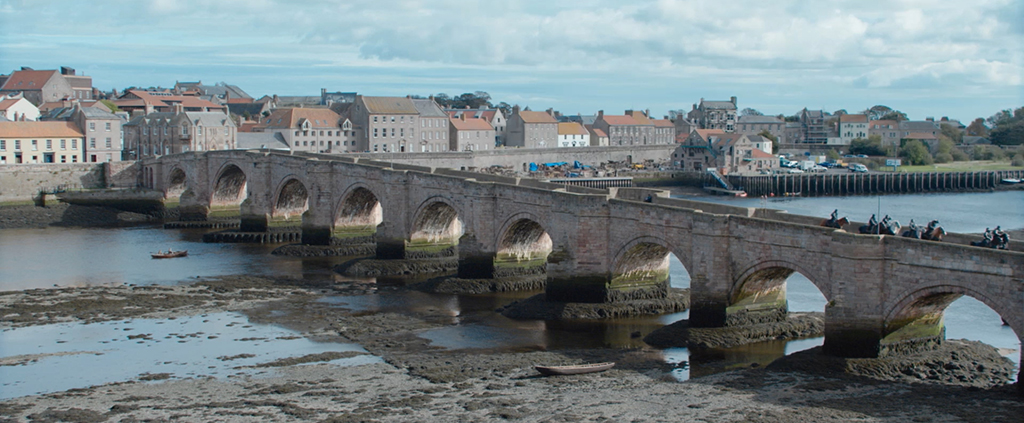
An original plate with period-correct buildings was filmed as the basis for the final shot.
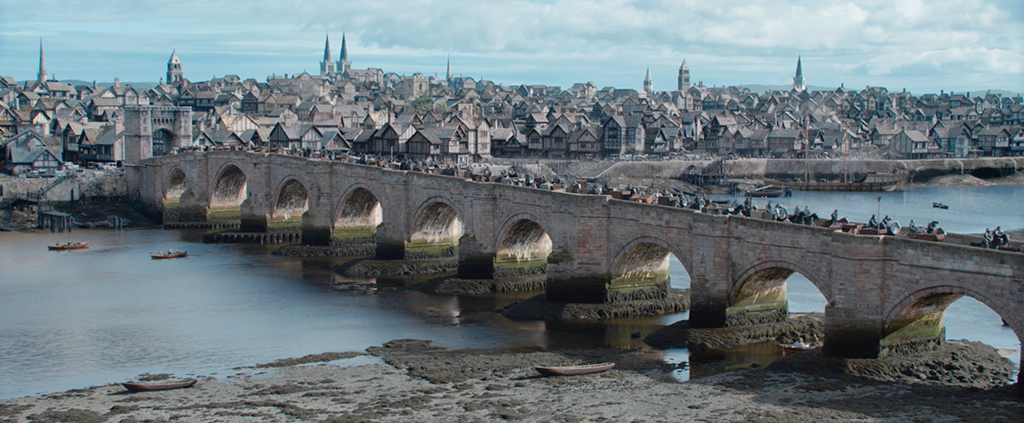
Method Studios enhanced the scene with extra horses and riders, as well as 14th century buildings.
“I said to [director] David [Mackenzie], ‘Let’s go to a place where there’s a castle.’” … I’d learned from previous projects … that if you just go to an empty field and you shoot and then say, ‘Put a castle there,’ you can never quite pull it off. If you go to the real location that had the real castle in, you’re getting so much more from it. And then the visual effects are about just scraping back the history.”
—Alex Bicknell, Visual Effects Supervisor
That approach and the ability of visual effects to enhance the action came to the fore early on in the film, when the awesome firepower of a trebuchet is shown in action launching a missile at a castle. It’s part of an eight-and-a-half-minute single Steadicam shot, and reveals the extent of an English encampment. Production filmed on a large set in Scotland, with many extras and tents and structures, along with the bottom half of the trebuchet. But for the reveal in the film – the trebuchet is set up as an enormous weapon – it was deemed that the prop needed to be a lot larger.
“We realized it needed to be a lot more vast in order to make the point in the story and to justify the cast’s expression when they look up,” says Bicknell. “So we ended up replacing it largely in CG. And we put the Stirling Castle on the hill in the background, and expanded on the troops and horses, just to add texture and busyness to the scene.”
The battle: horses and more
A Scottish force led by Robert the Bruce takes on the English forces at Loudoun Hill. It’s a bloody affair that involves a full English cavalry and significant hand-to-hand combat. The action involved horses and horsemen going full tilt against the Scots, action that would be captured as live-action stunts and enhanced with digital horses and riders from Method Studios.
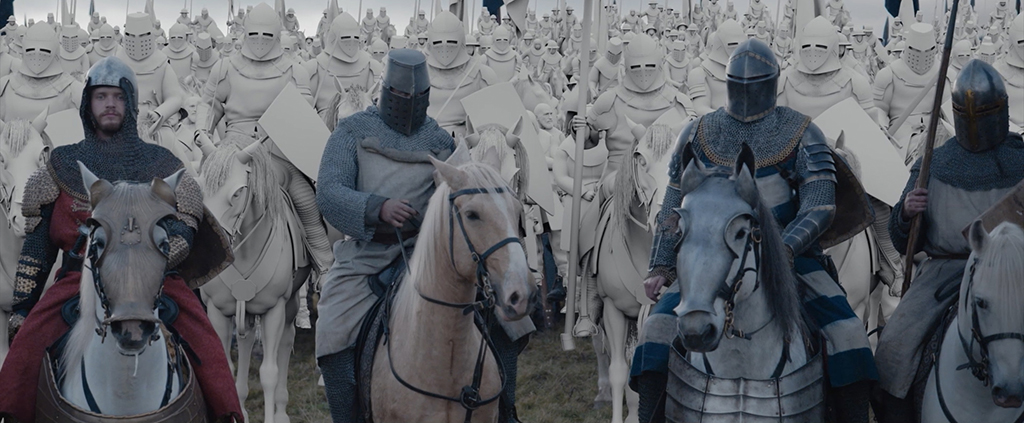
Method Studios’ CG horses and riders were placed right alongside live-action equivalents.
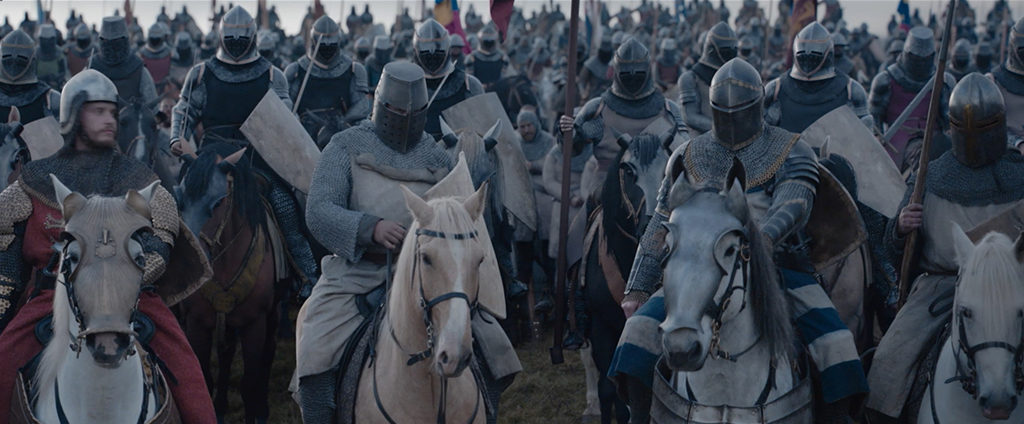
The final shot.
“One of the reasons we awarded the show to Method Studios was because of the excellent work they did on ‘Battle of the Bastards’ in Game of Thrones. It gave me confidence we could pull off soldiers and horses quite close to camera.”
—Alex Bicknell, Visual Effects Supervisor
“One of the reasons we awarded the show to Method Studios was because of the excellent work they did on ‘Battle of the Bastards’ in Game of Thrones,” says Bicknell. “It gave me confidence we could pull off soldiers and horses quite close to camera.”
Around 40 horses and hundreds of extras were filmed in live action. At the same time, Bicknell recruited the services of Lidar Lounge to conduct laser scans of the performers and environment to aid in recreating them in CG later on. “We set up a 200-camera capture booth on location,” explains Bicknell. “We got fantastic models of the real horses with and without their saddlery and all the soldiers, and all our principals as well.”
Method Studios also embarked on a two-day motion-capture shoot with stunt performers engaging in hand-to-hand combat and specific battle motions. “The visual complexity in a scene like this comes from the amount of variety you have in the motions,” states Method’s Dan Bethell, “and motion capture lends itself really well to populating crowds of agents fighting, rolling in the mud, getting pulled from horses, and firing bows and arrows.”
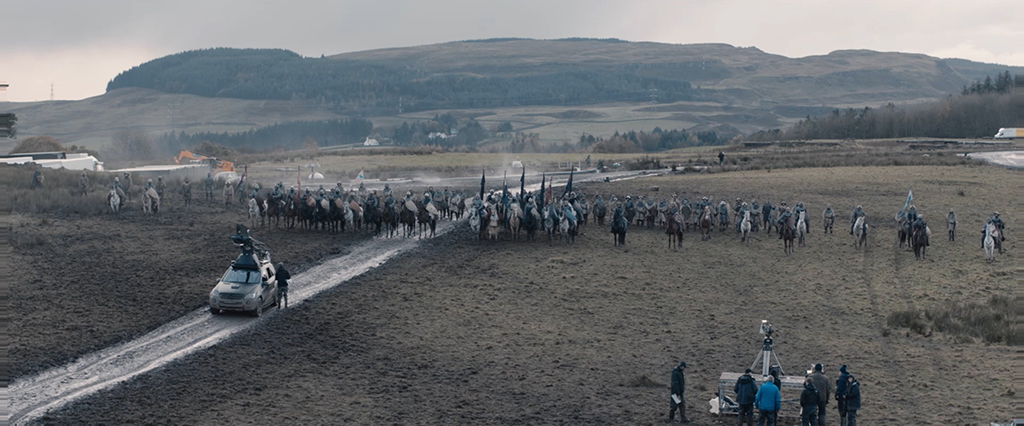
This frame shows how horses and riders were filmed on location.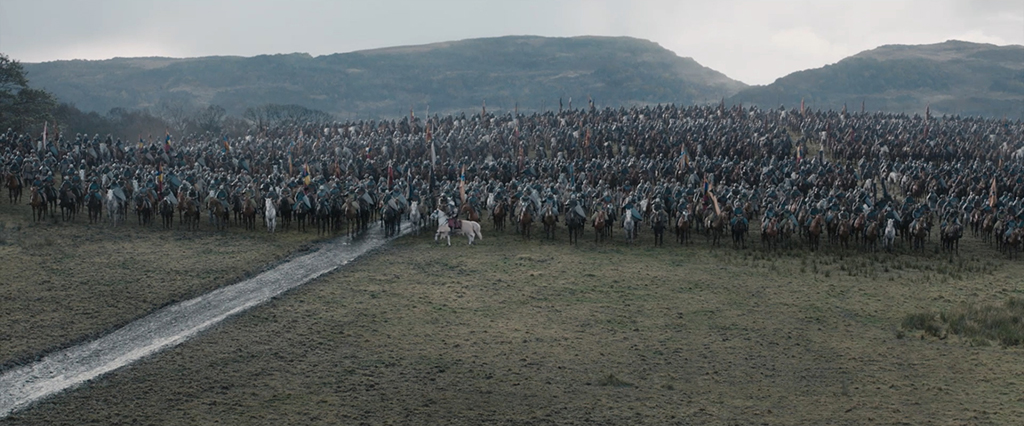
The final shot, with Method Studios’ digital cavalry.
“We set up a 200-camera capture booths on location. We got fantastic models of the real horses with and without their saddlery and all the soldiers, and all our principals as well.”
—Alex Bicknell, Visual Effects Supervisor
“It also let our animation team really focus on the up-close shots,” adds Bethell. “We did a lot of augmentation and replacement of SFX horses, which were either catapulted off a rig or pulled on a cable. Our animation team really focused on that, plus topping up the motion-capture library with some really nice bespoke set pieces of, say, three or four Scottish fighters descending on an English knight on horseback and stabbing the horse – things like that.”
A large amount of time was spent studying and replicating complex horse anatomy. “How you rig and set up your musculature and skin, the weighting of the neck muscles, and how big the head is proportional to the ears – all those things make a massive difference,” says Bethell. “And, of course, we didn’t want all our horses to be the same, so we had to build in some kind of procedural variation onto those.
“And then once you’ve got a model and rigged horse, the surfacing and the texture detail is incredibly hard. They have this beautiful, soft fur – it’s not really peach fuzz, it’s just soft fur up-close, but then they’ve got these beautiful manes and tails which are long-haired dynamics. The short fur shades very differently from the long hair, and they have amazing eyes which, if they don’t look right, you notice instantly.”
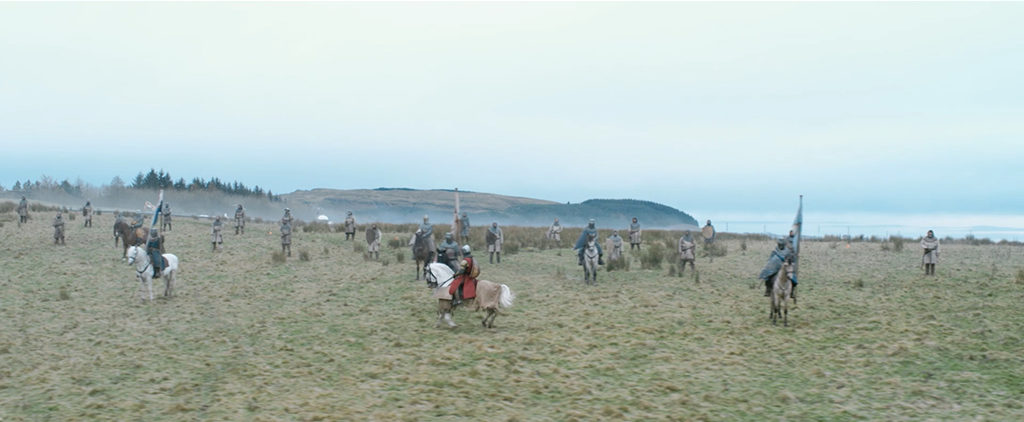
The original plate for a cavalry scene.
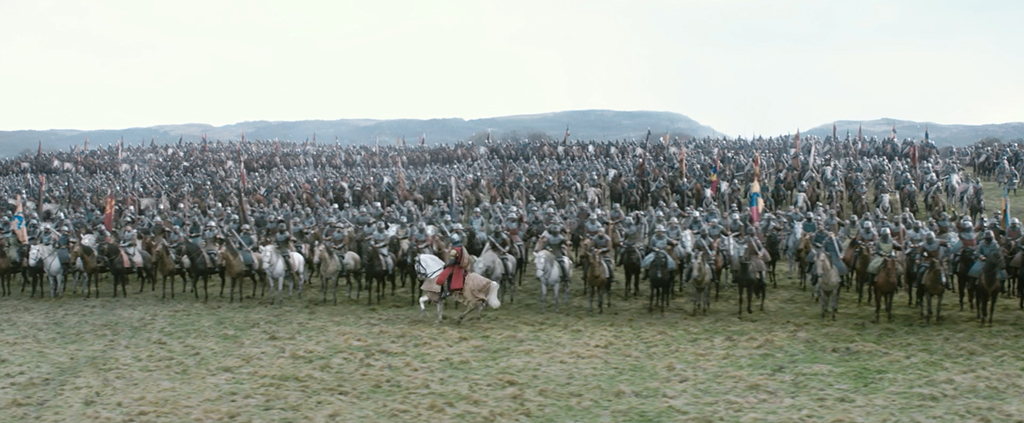
VFX artists were able to match their CG horses and soldiers with the live action.
“The visual complexity in a [battle] scene like this [with hand-to-hand combat] comes from the amount of variety you have in the motions, and motion capture lends itself really well to populating crowds of agents fighting, rolling in the mud, getting pulled from horses, and firing bows and arrows.”
—Dan Bethell, Visual Effects Supervisor, Method Studios
Further digital details included the bridlery and pieces of tack, saddles and the riders themselves. Procedural variations were built into these CG elements so that knights and soldiers and their different armor plating and weapons could be made. Bethell notes that once all these things came together in animated horse shots, he was convinced the sequence would work.
“We had some good static horses lined up and looking pretty good in a still frame,” he says, “but it wasn’t until we had the nuanced behaviors and the way where, even when horses stand still they’re never really still; they’re kind of shifting their weight from leg to leg, they flick their necks, the position of the head in proportion to the body – all those things elevated the shots, and that’s when I knew it was starting to come together.”
In addition to many ground-level scenes, helicopter-like views of the battle were realized almost completely in CG, although they were based on aerial plates. Method Studios devised its own crowd system for horse, riders and soldiers inside of SideFX Houdini.
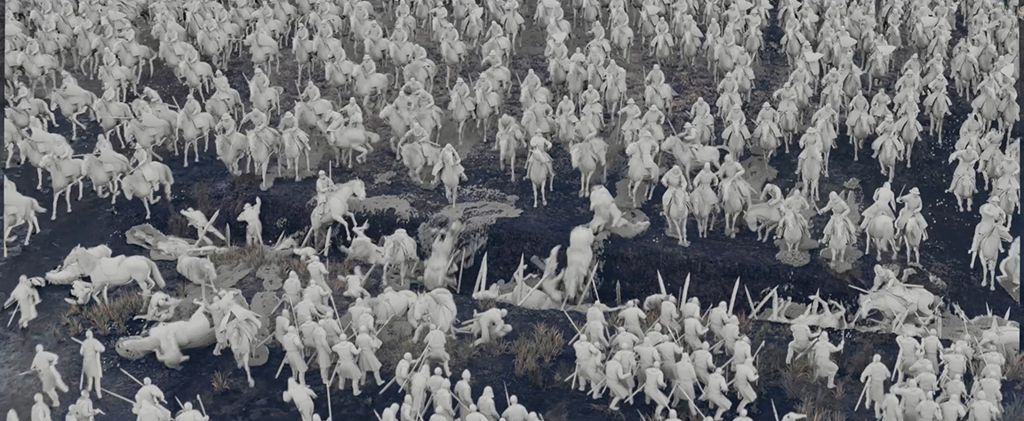
Aerial views of the battle made use of crowds generated with a bespoke Method Studios solution. This frame shows the CG elements.
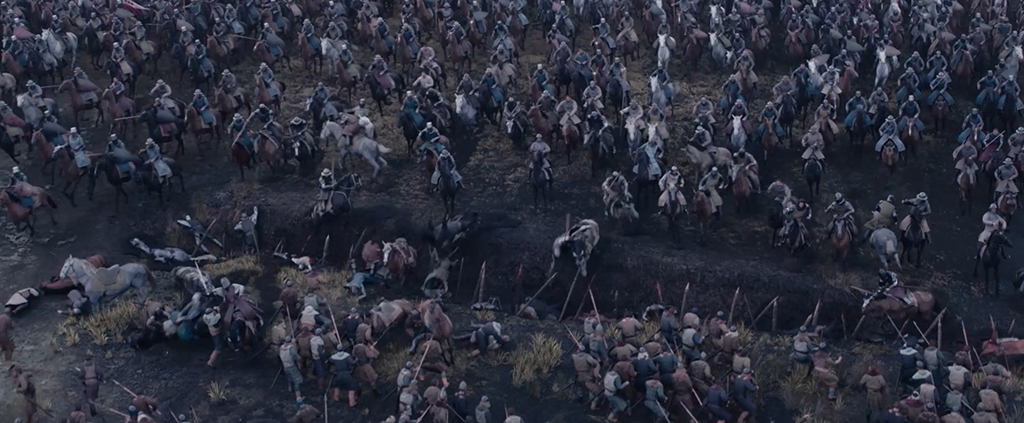
Final rendered shot.
“The visual complexity in a [battle] scene like this [with hand-to-hand combat] comes from the amount of variety you have in the motions, and motion capture lends itself really well to populating crowds of agents fighting, rolling in the mud, getting pulled from horses, and firing bows and arrows.”
—Dan Bethell, Visual Effects Supervisor, Method Studios
Going for gore
The visual effects team was also responsible for countless effects gags in the battle, as Bicknell details. “We pre-dressed some wounds and then painted them out and revealed them, and we had blood bags and stubby swords. Most of the work was about tracking in CG swords and adding in CG blood.
“With the majority of the shots,” adds Bicknell, “we started with 100%, which was always quite fun. There were these massive explosions of blood. We pulled them back until we got them into a place we felt was slightly more naturalistic. David wanted to portray war not as a glamorous thing, but really as quite a physical act, and it’s part of the tapestry of the film.”
Method Studios’ approach to gore shots in the battle, says Bethell, was really to compliment the original action in the plate. “Often, the amazing stunt team would come up with something really dynamic in camera, but then to sell it, you’ve really got to look at the direction the weapons are moving and the impact of where they hit.”
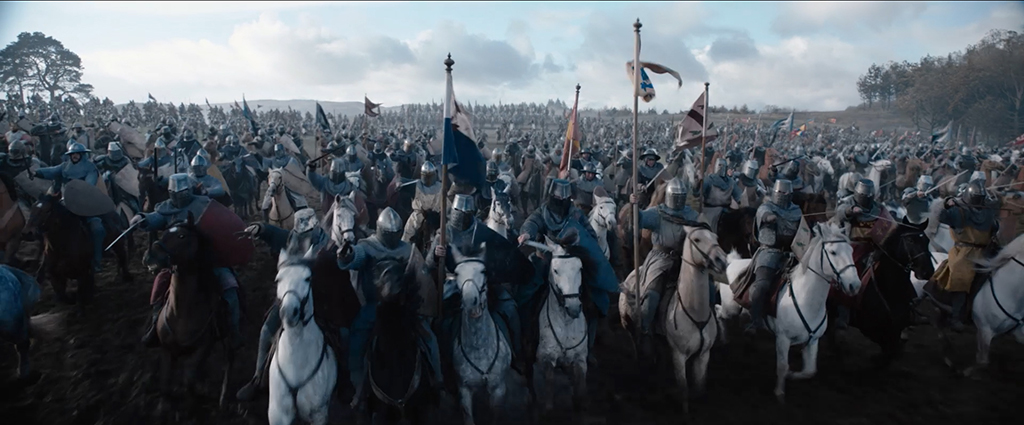
The final fierce battle included many gory moments, with VFX artists adding in weapon extensions, blood hits and wounds.
The smallest details
The battle is certainly one of the film’s main visual effects highlights, but it was just part of the many moments of VFX intervention in the film. Bicknell praises the work of artists in making the landscapes as authentic to the period as possible, something he actually referred to during production as ‘14th century compliancy.’ That kind of work, interestingly, was perhaps best illustrated by the requirement to remove a very specific artifact from the plates.
“One thing we had to get rid of, which was a huge task, was pine trees,” says Bicknell. “The pine was brought in, I think, in the early 20th century for farming purposes. So wherever we saw big thickets of forested pine, we had to remove those and replace with deciduous trees. That was a quite a big undertaking, but it really helped.”
